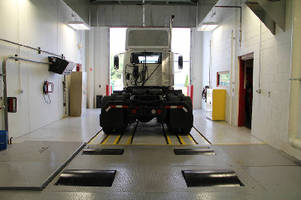Chassis Dynamometer Testing - Key Upgrade Considerations

Five reasons why the time is now to upgrade your chassis dynamometer testing system
When it comes to chassis dynamometers, the roll assembly hardware can maintain high functionality for years. In fact, a wave of innovation in the 1980s led to many installations still in operation today. As the old adage goes, “if it ain’t broke, don’t fix it.” The catch is you’re likely in the businesses of troubleshooting. And OEM dealers and distributors today face more sophisticated troubleshooting challenges than older systems can deliver – and much of it is to do with the instrumentation.
As you assess your system troubleshooting capabilities to meet today’s challenges, here are five key reasons you should consider upgrading your system, and what you can do to address them.
Capturing all of your data with a single system
If you are not capturing all of your data with a single data acquisition and control system, consider all of your time spent connecting the various systems and instruments to your vehicle and engine. After each test, this data needs to be manually synchronized and compiled before it can be analyzed and reports generated. Single systems allow a range of data to be captured through a common system to save time and labor.
Of course with a single data acquisition and control system, it’s more than convenience; it’s also capabilities in terms of information channels. Today, the latest instrumentation systems can read more than 350 information channels – and that’s in direct relation to needs being driven by advanced engine developments – allowing your system to read a greater range of data without interruption.
Communicating with ECMs
Speaking of evolving engines, can your system communicate with ECMs? All engines being produced today are electronically controlled, period. Each engine contains an electric control module (ECM) – a computerized system – that controls a host of protocols which are typically defined as SAE (Society of Automotive Engineers) or ISO (International Organization for Standardization) protocols. Several different types of protocols exist, such as the common automotive language called OBD-II. By upgrading EMC interfacing capabilities with current instrumentation, your system will be able to communicate with ECMs across a broader range of protocols, ultimately enhancing troubleshooting capabilities.
Keeping pace with industry trends
The engine and truck markets continue to change dramatically in terms of how data is released and broadcasted. It’s important to keep in mind that engine and truck manufacturers are becoming more integrated. This means more OEMs are making their own engines and putting them on their own chassis – moving data acquisition beyond engine data alone, to include transmission, rear end and all kinds of chassis data. Don’t limit your troubleshooting capabilities to previous engine models, upgrade your instrumentation system to troubleshoot engines coming off the line today.
Making operation intuitive for ease-of-use
Another reason to upgrade is advanced troubleshooting today can complicate operation. As troubleshooting becomes increasingly sophisticated, the need to balance data acquisition with ease-of-use is critical. That’s why instrumentation is making dynamometer testing more intuitive to operate. Whether its out-of-the-box pre-packaged tests, with scalability to evolve along with troubleshooting needs, or software that can simulate real-life conditions, or even the ability for programmed output of pass-fail reporting, it’s allowing operators to maintain focus on testing.
Ensuring efficiency and durability
Sure, a lot of the need for upgrading a system centers on data acquisition capabilities. But with an estimated 500 systems installed in North America and the majority of those nearing the end of a lifecycle, what is the state of your hardware? One key reason to upgrade older hardware is that these systems contain gearboxes between roll sets which are inefficient at lower operating speeds as opposed to newer systems that have engineered out the gearbox. New systems accommodate this through a larger diameter absorber and direct drive. Additionally, whereas previous iterations of roll sets have a 2.5 inch diameter shaft, today’s roll sets are designed with 4 inch diameters – and that means a more robust system.
Troubleshooting your own needs
Even for the most seasoned or experienced OEM dealer or distributor, there’s a lot to know about troubleshooting in today’s world. If any of the above reasons have you thinking, “maybe it’s time to consider updating,” the good news is you don’t have to troubleshoot your situation alone. Your best bet is to consult the experts to help you assess your situation and provide a clear picture of system configuration selections, including initial investments and projected maintenance costs. An expert can also work with you to balance these costs with your specific specific site conditions and specifications to help you determine an anticipated ROI. Select an expert that can bring insights from previous installation eras to the present – Taylor Dynamometer is one.
Did you know: Taylor Dynamometer has a unique history in the chassis dynamometer market with experience dating back to the 1960s? In a previous wave of engineering innovation, Taylor – along with two other companies now under the Taylor umbrella – helped hundreds of OEM dealers and distributors install chassis systems with large-roll hardware to meet the industry needs 30 years ago. The result – 4 of 5 chassis dynamometers in the North American market are Taylor made. Today, Taylor continues to lead technology forward with new systems from hardware to instrumentation to meet the industry’s evolving needs. To learn more about Taylor’s complete chassis dynamometer system offerings, visit Taylor online.




